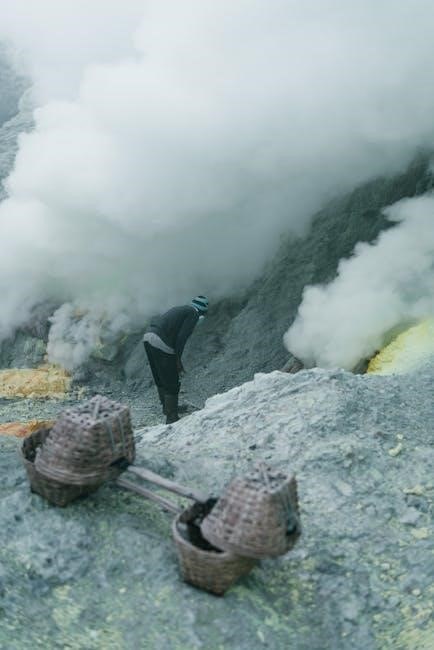Firex Smoke Alarm Owner’s Manual: A Comprehensive Guide
Welcome to your comprehensive resource for Firex smoke alarms. This guide provides essential information for operating and maintaining your device. Remember‚ smoke alarms are critical for safety. This manual is designed to help you understand alarm functionality and ensure optimal performance.
Firex smoke alarms are essential safety devices designed to provide early warning in the event of a fire. Manufactured initially by Invensys Controls‚ the Firex brand was later acquired by Kidde in 2009. While Invensys Controls no longer supports these products‚ understanding their operation and maintenance remains crucial for homeowners. These alarms‚ typically AC/DC powered with battery backups‚ utilize ionization sensing technology‚ known for quickly detecting invisible fire particles associated with flaming fires.
It is crucial to note that older Firex models may require replacement with newer units to maintain interconnectivity. When replacing‚ ensure compatibility and consider using quick convert adapters like the Kidde KA-F to simplify wiring changes. Remember‚ a functional smoke alarm is your first line of defense against fire hazards. Always refer to the user manual for model-specific instructions and safety guidelines. This manual will guide you through installation‚ testing‚ and troubleshooting to keep your home and family safe; Keep this document handy for future reference and ensure all household members are familiar with its contents.
Identifying Your Firex Model
Accurately identifying your Firex smoke alarm model is crucial for accessing specific instructions and ensuring proper maintenance. Firex produced a variety of models‚ including the i4618‚ 4418‚ ADC‚ and 5000 series‚ among others. Each model may have unique features or replacement requirements. Begin by visually inspecting the alarm unit itself. The model number is typically printed on the front‚ back‚ or side of the alarm housing. Look for labels or stickers containing alphanumeric codes like “i4618AC” or “FADC.”
If the label is worn or illegible‚ check any accompanying documentation you may have‚ such as the original packaging or owner’s manual. These documents usually contain the model number and other relevant information. Online resources‚ such as the Kidde website (the current manufacturer)‚ can also help identify your model based on visual characteristics or features. Knowing the model number allows you to find the correct user manual‚ replacement parts‚ and troubleshooting guides. This ensures you can properly maintain your alarm and keep it functioning effectively to protect your home and family. Always cross-reference information to confirm accuracy.

Understanding the Manual’s Purpose
This manual serves as a comprehensive guide to ensure the proper installation‚ operation‚ and maintenance of your Firex smoke alarm. Its primary purpose is to equip you with the knowledge necessary to protect your home and family from the dangers of fire. By understanding the information contained within‚ you can maximize the effectiveness of your smoke alarm and respond appropriately in the event of an emergency.
The manual provides detailed instructions on selecting optimal locations for smoke alarm placement‚ avoiding areas that may cause false alarms or hinder performance. It outlines the correct installation procedures‚ including wiring configurations and mounting techniques. Furthermore‚ the manual explains how to test the alarm regularly to verify its functionality and how to interpret different alarm signals. Troubleshooting tips are included to address common issues‚ such as nuisance alarms or low battery warnings. This manual also covers essential maintenance tasks‚ such as cleaning the alarm to remove dust and debris. Finally‚ it clarifies the limitations of smoke alarms and emphasizes the importance of having a comprehensive fire safety plan. By carefully reading and understanding this manual‚ you can ensure your Firex smoke alarm provides reliable protection for years to come. Keep it readily accessible for future reference.
Recommended Locations for Smoke Alarm Installation
Strategic placement of smoke alarms is crucial for early fire detection and ensuring the safety of your household. It is highly recommended to install smoke alarms on every level of your home‚ including the basement. At a minimum‚ install one smoke alarm outside each sleeping area‚ such as hallways leading to bedrooms. For enhanced protection‚ place a smoke alarm inside each bedroom‚ especially if occupants sleep with the doors closed. This ensures that occupants are alerted even if a fire starts within their room.
When installing alarms on ceilings‚ position them at least 4 inches from the wall. On walls‚ mount them 4 to 12 inches from the ceiling. In rooms with sloped or peaked ceilings‚ install the smoke alarm within 3 feet of the peak. Interconnecting smoke alarms is highly recommended‚ so that if one alarm sounds‚ all alarms throughout the house will activate‚ providing an early warning to everyone in the building‚ regardless of their location. Always consult local building codes and fire safety regulations for specific requirements in your area. Remember‚ proper placement of smoke alarms dramatically increases the chances of early detection and safe evacuation during a fire emergency. Regularly test alarms after installation to ensure they are functioning correctly.
Locations to Avoid for Smoke Alarm Installation
To ensure optimal performance and prevent nuisance alarms‚ it’s essential to avoid certain locations when installing your Firex smoke alarms. Do not install smoke alarms near kitchens‚ as cooking fumes can trigger false alarms. Maintain a distance of at least 10 feet from cooking appliances. Similarly‚ avoid installing alarms near bathrooms‚ where steam from showers and baths can cause false alarms. Laundry rooms are also unsuitable due to lint and dust accumulation.
Avoid placing smoke alarms in areas with excessive dust‚ insects‚ or grease‚ as these can contaminate the sensor and impair its functionality. Do not install alarms in “dead air” spaces‚ such as the corner where the wall meets the ceiling. Air circulation is limited in these areas‚ which can delay smoke reaching the sensor. Avoid placing alarms near vents‚ fans‚ or air conditioning units‚ as drafts can blow smoke away from the sensor. In mobile homes or RVs‚ avoid installing alarms in poorly insulated exterior walls or roofs‚ where temperature extremes and humidity can affect performance. Always refer to your local fire codes for specific regulations and recommendations. Proper placement is vital for reliable smoke detection.
Installation Instructions
Before you begin‚ ensure you have all the necessary tools and materials‚ including a screwdriver‚ drill‚ and appropriate mounting hardware. Always disconnect power at the breaker before working with electrical wiring. Remove the existing smoke alarm if replacing an old unit. Identify the wiring harness: typically‚ black (hot)‚ white (neutral)‚ and orange (interconnect). If replacing an older Firex model‚ you might need a Kidde KA-F adapter for easy conversion without rewiring.
Connect the wires from the building’s electrical system to the corresponding wires on the smoke alarm harness‚ using wire connectors to secure the connections. For interconnected alarms‚ connect the orange wire to the corresponding wire on the other alarms. Mount the alarm to the ceiling or wall using the provided screws. Ensure the alarm is securely fastened. Install a 9V battery for backup power‚ if applicable. After installation‚ restore power at the breaker and test the alarm by pressing the test button. If the alarm fails to sound‚ check the wiring and battery connections. Repeat the installation process for all smoke alarms in your home. Regularly test your alarms to confirm they are functioning correctly.
Operation and Testing Procedures
Your Firex smoke alarm is designed for continuous operation‚ providing constant monitoring for smoke particles. The alarm operates on 120V AC power‚ with a 9V battery backup for power outages. In normal operation‚ a small green LED light may indicate that the alarm is receiving power. To test the alarm‚ press and hold the test button on the cover for several seconds. A loud‚ continuous alarm sound indicates proper function.
Test your smoke alarm weekly to ensure it is working correctly. If the alarm fails to sound during the test‚ check the AC power connection and the battery. Replace the battery immediately if it is drained or improperly connected. Never remove the battery or disconnect AC power to silence unwanted alarms‚ as this will remove your protection. Instead‚ open windows or fan the air around the alarm to clear any smoke or particles that may be causing a nuisance alarm. Regularly check that the green power indicator is lit‚ confirming that the alarm is receiving power. This ensures your alarm is always ready to protect you and your family.

Interconnecting Firex Smoke Alarms
Firex smoke alarms can be interconnected‚ creating a network of protection throughout your home. When one alarm detects smoke‚ all interconnected alarms will sound‚ providing early warning regardless of the fire’s location. This feature is particularly useful in larger homes or those with multiple levels. Firex alarms can be interconnected with up to 11 other Firex smoke alarms (models FADC‚ AD‚ ADC‚ PAD‚ or FX1218) and up to 6 Firex heat alarms (model ADH)‚ for a maximum of 18 interconnected devices.
When interconnecting‚ ensure compatibility between models. Do not connect Firex alarms to other brands or auxiliary devices not listed in this manual. A unique power connector prevents interconnection with incompatible systems. To interconnect‚ follow the wiring instructions carefully‚ typically involving a three-wire connection (red‚ white‚ and orange). If replacing an older Firex alarm‚ a new wiring harness might be necessary. If you are unsure about the wiring‚ consult a qualified electrician. Interconnection provides an added layer of safety‚ ensuring everyone in your home is alerted in the event of a fire. Regular testing of all interconnected alarms is crucial to confirm the system’s overall functionality.
Addressing Nuisance Alarms
Nuisance alarms‚ also known as false alarms‚ can be frustrating. These alarms occur when the smoke alarm sounds even though there is no fire. Common causes include steam from showers‚ cooking fumes‚ dust‚ insects‚ and even high humidity. Understanding the causes is the first step in prevention. To address nuisance alarms‚ first‚ identify the source. If it’s steam or cooking fumes‚ improve ventilation by opening windows or using exhaust fans.
For dust or insects‚ regular cleaning of the smoke alarm is essential. Use a vacuum cleaner with a brush attachment to gently remove debris from the alarm’s exterior. Never use water or cleaning solutions directly on the alarm. If the alarm is located near a bathroom or kitchen and nuisance alarms are frequent‚ consider relocating it to a more suitable location. Some Firex alarms have a “hush” button that temporarily silences the alarm for a few minutes‚ providing time to clear the air. However‚ never disable the alarm or remove the battery to silence it permanently‚ as this eliminates fire protection. If nuisance alarms persist despite these measures‚ consult a qualified electrician or contact customer support for further assistance or consider replacing the alarm.
Maintenance and Cleaning
Regular maintenance and cleaning are crucial for ensuring the proper functioning of your Firex smoke alarm. Dust and debris can accumulate inside the alarm‚ affecting its sensitivity and potentially causing false alarms. A simple cleaning routine can prevent these issues and prolong the life of your alarm. It’s recommended to clean your smoke alarm at least once every six months‚ or more frequently if you live in a dusty environment.
To clean your Firex smoke alarm‚ start by turning off the power to the alarm‚ if applicable. Then‚ use a vacuum cleaner with a soft brush attachment to gently remove dust and debris from the exterior of the alarm. Pay close attention to the vents and openings‚ as these are where dust tends to accumulate. Avoid using water or any cleaning solutions‚ as these can damage the internal components of the alarm. After vacuuming‚ use a clean‚ dry cloth to wipe down the exterior of the alarm. Once the alarm is clean and dry‚ restore power and test the alarm to ensure it’s functioning correctly. Remember to replace the battery at least once a year‚ or as indicated by the alarm’s low battery warning. Consistent maintenance will ensure your Firex smoke alarm remains a reliable safeguard for your home and family.
Troubleshooting Common Issues
Even with proper maintenance‚ you might encounter occasional issues with your Firex smoke alarm. Understanding common problems and their solutions can help you quickly restore its functionality. One frequent issue is nuisance alarms‚ which can be triggered by steam‚ cooking fumes‚ or dust. If you experience a nuisance alarm‚ first ensure there’s no actual fire. Then‚ ventilate the area by opening windows or using a fan.
Another common problem is a chirping sound‚ which usually indicates a low battery. Replace the battery immediately with a new 9-volt alkaline battery. If the chirping persists after replacing the battery‚ the alarm may need to be replaced. If your Firex smoke alarm fails to sound during a test‚ double-check that the battery is correctly installed and has sufficient charge. Also‚ ensure the alarm is receiving power if it’s hardwired. If the alarm still doesn’t sound‚ it may be defective and require replacement. Before replacing‚ consult the manual for specific troubleshooting steps related to your model. Remember‚ addressing issues promptly ensures your smoke alarm remains a reliable safety device.
Limitations of Smoke Alarms
While smoke alarms provide crucial early warning of fires‚ it’s important to understand their limitations. Smoke alarms are designed to detect smoke‚ but they cannot prevent fires. They are only effective if they are properly installed‚ maintained‚ and functioning. Additionally‚ smoke alarms have a limited lifespan‚ typically around 10 years‚ after which they should be replaced.
Smoke alarms may not be effective if the fire starts in a remote area of the home‚ far from the alarm‚ or if the smoke is blocked by closed doors or other obstructions. They also may not detect slow-smoldering fires that don’t produce much visible smoke. Furthermore‚ smoke alarms rely on occupants being able to hear the alarm and react accordingly. Individuals who are deaf or hard of hearing‚ or those under the influence of drugs or alcohol‚ may not be able to respond effectively. Finally‚ it’s crucial to remember that smoke alarms are just one component of a comprehensive fire safety plan‚ which should also include fire extinguishers‚ escape routes‚ and regular fire drills.

Warranty Information and Replacement
Your Firex smoke alarm typically comes with a limited warranty from the manufacturer‚ covering defects in materials and workmanship. The specific terms and duration of the warranty can vary depending on the model and date of purchase‚ so it’s essential to consult the warranty information included with your device or on the manufacturer’s website. If your smoke alarm fails to function properly during the warranty period‚ you may be eligible for a repair or replacement‚ subject to the warranty’s conditions.
When replacing your Firex smoke alarm‚ consider models compatible with your existing wiring harness to avoid rewiring‚ or use a Kidde KA-F adapter for easy conversion. Given that Firex is now under Kidde‚ ensure the replacement is a Kidde-compatible model. Remember that smoke alarms have a limited lifespan‚ typically 5 to 10 years‚ after which they should be replaced regardless of functionality. Always dispose of old alarms properly‚ following local regulations for electronic waste disposal. Replacing all alarms simultaneously ensures consistent communication between interconnected units. Keep records of purchase dates and model numbers for warranty claims and future replacements.


Leave a Reply
You must be logged in to post a comment.